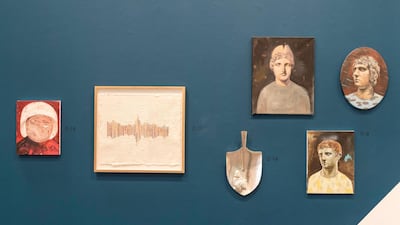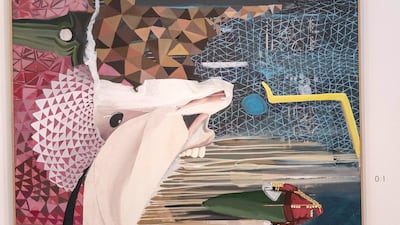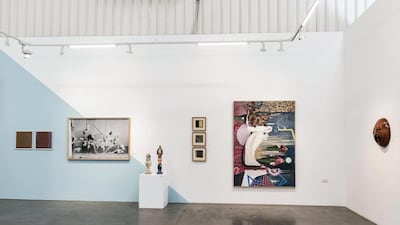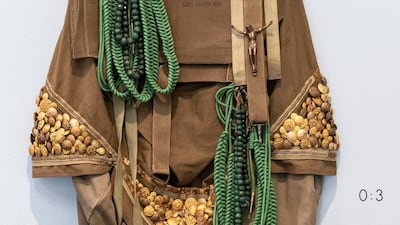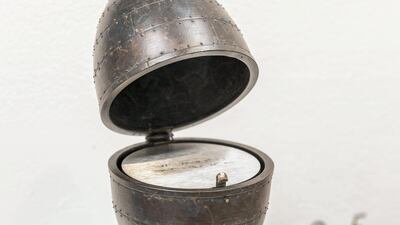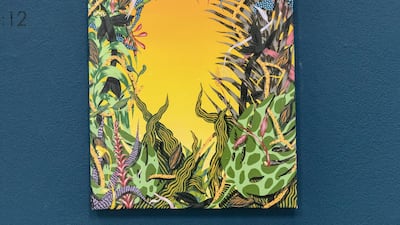"During Ramadan, it's all about community," says Asmaa Al-Shabibi of her gallery's Each Day an Artist project, which was inspired by Ramadan.
The Lawrie Shabibi gallery is hanging an artwork by a new artist every day this month – by artists the gallery represents, and those from their neighbours in Alserkal Avenue.
"It's looking mad – there are going to be 30 artists," laughs Al-Shabibi, a veteran of Dubai's art world with a generous disposition. "Thirty is based on the Ramadan days, and this kind of build-up of time," she says. "If you're fasting, every day is like a countdown – and every hour is like a countdown – from sunrise to the sunset. It's a very time-based period."
Al-Shabibi, who co-runs the gallery, started the exhibition with Madame Tussauds VI (2015) by the Dubai trio Rokni Haerizadeh, Ramin Haerizadeh and Hesam Rahmanian, who are represented by Galerie Isabelle van den Eynde, four doors down. "I went to see Isabelle about the show," Al-Shabibi says, "She had the painting in her office. I said, 'That's an amazing one – could I have that?'. And then everything else was built around it."
The painting depicts, sideways, an image from the wedding of the Duke and Duchess of Cambridge: Princes William and Harry in the background and the Middleton sisters, with wedding train held aloft, in the foreground. The faces are obscured in the painting's collage of Bacon-esque Surrealism and harlequin geometry. When I saw it, two young girls bent their necks to look at the marriage scene: "faces are tricky to paint," one commiserated.
It was followed, the next day, by Kamrooz Aram's painting of vegetal motifs – a work he made by applying and then wiping away paint, erasing and rebuilding the work (this is on loan from Green Art Gallery). Day five featured one of Larissa Sansour's bronze sculptures, which resemble the unholy offspring of a bomb and a Faberge egg, and contain co-ordinates of locations in the West Bank in which Sansour has buried bits of pottery.
The Palestinian artist has called this interred project a "reverse archaeology" that might one day offer the future a different understanding of life in the Occupied Territories in the 21st century.
On day eight, two earthenware sculptures by Monika Grabuschnigg, who has a solo show at Carbon 12, were on a plinth – dripping in colour but inscrutable in terms of purpose. For day ten, three works of geometry on handmade paper from Zarina Hashmi, from across the lane at 1x1 Gallery, were hung on the wall, followed by two psychedelically coloured paintings six days later. Made by the Iranian, Los Angeles-based artist Amir Fallah, they show ominous tangles of plant life and a figure obscured by fabric striped in the colours of the Iranian flag. It is on loan from the Third Line.
Al-Shabibi chose the works well beforehand, then put them in Lawrie Shabibi’s storage until their debuts. There hasn’t been much of plan about running order of the pieces. “Eighty per cent is chosen in the morning before the show. It’s very spontaneous,” she says. “It’s literally, what do we feel like hanging today?”
The show has become popular on Instagram, where every day the gallery posts the new artwork accompanied by a blurb about it.
Before the works went up, the gallery painted the walls in diagonals of dark blue, duck egg and mauve, so the space wouldn’t look excruciatingly bare in the early stages.
“It’s been a really challenging hang – I’ve had to keep in mind that I’ve got to leave space for another ‘x’ number of artists,” says Al-Shabibi. “In the entrance every few days we’ll print cards of the artworks, taken from Instagram. The real becomes online and the online becomes print.”
Despite the way it has been put together, a phalanx of shared issues has emerged, making the exhibition a reflection on the artists supported by the Alserkal Avenue community. “A lot of the galleries have similar themes – identity, a meeting of Eastern and Western motifs. Sara Rahbar’s is quite similar to a work by Larissa Sansour, for example. There are ideas that are coming up that aren’t pre-planned – they’re intuitive,” says Al-Shabibi.
If you want to use art-world terms, this is an experiment in durational exhibition-making. Or put simply, it’s a show among friends.
Each Day an Artist is at Lawrie Shabibi, Alserkal Avenue, Dubai, until September 1
What is Durational Exhibition-Making, Anyway?
“What if an exhibition was not about occupying space but about occupying time?” This was the question asked by the 2007 project “Il Tempo del Postino” (this is haute art-world stuff so you have to say it in the original Italian, even though it debuted in Manchester). Curated by Hans Ulrich Obrist and Philippe Parreno, the exhibition brought together a group of artists active in the movement of Relational Aesthetics – a label they all, naturally, disavow – which sought to understand the art object and exhibition around social rather than material lines. What if art’s purpose was just to bring people together in a better way?
For "Il Tempo del Postino" Obrist and Parreno set a series of rules: 15 artists would each make a new work, no longer than 15 minutes, in any medium except film or video. Despite a typically morose reaction in the press – the Guardian wrote "The problem with conceptual art in postman performance is that you are stuck with the punchline for as long as the artist's self-indulgence allows" – it has become an important exhibition.
There are plenty of other examples of exhibitions that change day by day: the Chiang Mai Social Installation's Weeks of Co-operative Suffering of 1995; the Berlin Biennale of 2008; exhibitions where the artist lives in the gallery (too many to count) but Lawrie Shabibi's might be the first to link the form to Ramadan – a new first for our city of firsts.
____________
Read more
At Lawrie Shabibi, Serge Attukwei Clottey shows Dubai how he disrupts the art trade
Artists investigate public entertainment at the Maraya Arts Centre
Farjam Foundation exhibition looks at bordering nations
____________
